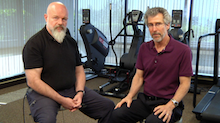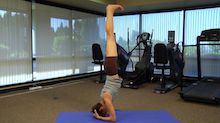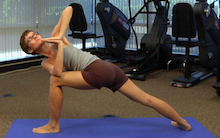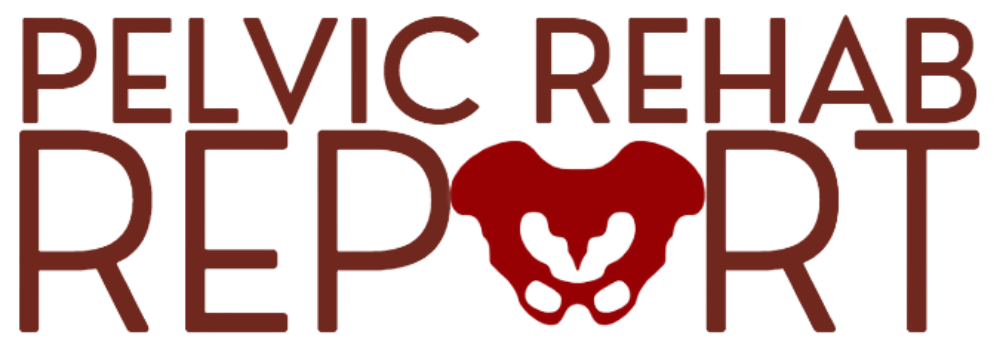I would estimate that a large majority of pelvic rehabilitation providers are current or past students of yoga- some of you may even be experienced or new yoga teachers. As a yoga student myself (of various teachers and approaches, and a tendency to wish I was more consistent with my own practice) I have often marveled at how old and well-founded so many yogic practices are in relation to the "new" techniques "discovered" by entrepreneurial practitioners in health-related fields. Look at pelvic muscle activation: by engaging our patients in awareness techniques involving the pelvic floor we are continuing a long tradition of a yogic principle. This principle, known to many as mula bandha, is an ancient phrase often interpreted as referring to "root" and "lock."
Over the past 5 years I have observed a tremendous increase in yoga practitioners who are interested in not only exploring the ability of the locking or stabilizing ability of the pelvic muscles, but also in exploring the necessity to "unlock" the person who is holding too much tension in the base of the spine and pelvis. The discussions related to this issue are at times hotly debated as well as thoughtful and elegant. One article might suggest a flow within which mula bandha can be integrated, and other articles warn against the overuse of the lock and the lack of awareness required to properly use mula bandha during asanas.
Last year I was approached by a local yoga school and studio, Yoga North, to learn more about how they were already incorporating pelvic floor awareness and practices into curriculum and classes dedicated to pelvic health. I had an opportunity to attend a class by a yoga teacher trained in their curriculum and in somatics, and I was very impressed at the language and techniques used to improve pelvic muscle awareness. More than ever, pelvic rehabilitation providers have an opportunity to engage other community practitioners and teachers so that we can learn from each other. It is not necessary that we speak each other's languages fluently, but that we find the common principles and share successes and challenges with which our patients/students present.
Another valuable resource recently announced is the coursework created by Ginger Garner in Medical Therapeutic Yoga. Check out her website for more background information and the course information available at MedBridge Education. If you prefer to see Ginger at a live course, she will offer "Yoga as Medicine" courses for peripartum issues- check these courses out on the Institute's home page for courses. Dustienne Miller is also offering this weekend! her new Yoga for Pelvic Pain course. You may have seen her well-attended presentation at CSm this year in San Diego. If you would like to host one of these courses at your facility, please contact the Institute.
We are thrilled to announce the launch of a brand new series of online courses, Integrative Techniques for Pelvic Floor & Core Function. This three-part series instructs on low-tech, non-invasive techniques to address pelvic floor dysfunction that draw from Yoga, Tai Chi, Qigong, Feldenkrais and conventional rehab therapies, with a goal of guideing clients toward improved health and function. These courses were developed and are instructed by Bill Gallagher, PT, CMT, CYT and Richard Sabel, MA, MPH, OTR, GCFP. Throughout each course in this series, Bill and Richard will walk you through various exercises that you are encouraged to perform at home, in order to better prepare you to guide your own patients through the same exercises in your setting of care.

Part A lays the foundation for the series by covering anatomy, core concepts related to "habits of the mind," and the physiology of breathing as it relates to the pelvic floor. Part B will begin by covering modifications of yoga poses to address soft tissue tightness, functional movement, and pelvic dysfunction. The pelvic clock in supine from Part A will be reviewed, and techniques for the facilitation of a client’s understanding of the pelvic clock will be presented. Part C concludes the series with integrating the pelvic floor muscles into everyday functional movements such as standing, lifting from a squat, bridging, and going up steps, as a means to maintain the suppleness (strength and flexibility) of the pelvic floor. These courses can be taken sequentially or in any order.

Don't miss Bill and Richard teaching their live seminar as well. The two course, Integrative Techniques for Pelvic Floor & Core Function: Weaving Yoga, Tai Chi, Qigong, Feldenkrais and Conventional Therapies will be held this September in New London, CT!
Two weekends ago in San Diego, Herman & Wallace offered the first course event of our brand new course, Care of the Pregnant Patient. This course is part of a new series on pregnancy and postpartum, written and developed by Herman & Wallace faculty members (as we call them, our "Preg-perts").
Lisa Lahr, DPT attended this course and wrote of her experience:
The course Care of the Pregnant Patient was a wonderfully put together course. The course outline and handouts were wonderful, easy to follow and gave the right amount of information. Many physical therapist work with pregnant patients who have pain during their pregnancy. We have all had the patient for whom we run out of ideas how to help and have thought that she would feel better once the baby is born. After this class, I do not feel like I will ever have to feel this way again. I have learned so many things that I can try and teach my patients to help with their pain during pregnancy.
Another key part of the class was discussing ways to market to providers and the community to grow a strong program for pregnant patients to attend. We also discussed ways to improve relationships between providers and therapy for this patient population.
Jenni Gabelsberg is a wonderful instructor with a very strong knowledge base in women’s health and pregnancy patients and she provided great examples of what we talked about in class.
Overall, this class allowed me to leave with many new “tricks in my tool bag” and a new appreciation for the things that we can do for a pregnant patients. I look forward to attending the Care of the Postpartum Patient and would highly recommend this class to anyone that treats pregnant patients.
We will be offering this course two more times in 2013: in April in Houston, TX and in September in Winter Park, FL.
You may recall that late in 2011, the United States Preventive Services Task Force created significant controversy by recommending againstroutine PSA (prostate specific antigen) testing. (A blog post from November 2011 covers the topic if you would like to review the recommendations.) The recommendations against use of routine PSA for prostate cancer screening is thought to avoid unnecessary biopsies as well as prevent urinary incontinence and erectile dysfunction related to procedures for prostate cancer. In this year's January edition of the Annals of Internal Medicine we have updated information that addresses the implications of screening among different age groups.
Authors from the Fred Hutchinson Cancer Research Center and the University of Washington in Seattle ran computer models to determine risk reduction and mortality levels in populations of men. The bottom line is this: in men who are at low risk of developing prostate cancer, reducing the frequency of PSA testing significantly reduces the potential for harm from interventions, while not significantly increasing the risk of death. For example, in men ages 50-74 (who have low PSA levels) screening every other year versus annually increases lifetime death risk by 0.1% The number of PSA tests would be reduced by 59% and false positive tests (blamed for significant amount of pain and unnecessary treatments) would be reduced by nearly half. Click here for the journal abstract.
Even if you are not working specifically with male pelvic rehab patients, you are likely working with male patients who are at an age when screening for prostate disease is recommended. How else can we promote prostate health with our patients? The Fred Hutchinson Cancer Research Center has found that eating dark green and cruciferous vegetables, drinking moderate amounts of red wine, and avoiding deep fried foods, smoking, and obesity can improve a man's chances of avoiding prostate cancer. As with many cancers, family history plays a role. Screening male patients, especially those who are in their 5th decade of life, is important. The American Cancer Society estimates more than 238,000 new cases of prostate cancer will be diagnosed this year in the US. Be alert to male patients who have pain in the low back or pelvis, as these areas are typical sites of metastasis. The National Cancer Institute has an excellent summary of prostate cancer risks, general information, and images related to anatomy that you might find useful for your own knowledge or for patient education.
In March of this year, H&W is thrilled to be offering a brand new course on Pudendal Neuralgia. Our Pelvic Rehab Report blogger interviewed the two instructors Loretta J. Robertson, PT, MS and Tracy Sher, MPT, CSCS about their course.

1. What can you tell us about this continuing education course that is not mentioned in the "course description" and "objectives" that are posted online?
Loretta: First, I just want to say we are both thrilled to be able to present this course and share all that we have learned in working with these patients. I have always wanted instructors in continuing education courses to “walk me through” their thinking processes. “Why did this patient history and presentation guide you toward diagnosis or treatment A as opposed to B?” So we are going to incorporate that information throughout the entire course.

Tracy: Yes- this is exciting for us to have this opportunity to blend anatomy and science with clinical decision making. We both see patients from all over the country (and world) who are concerned about having pudendal nerve entrapment or pudendal neuralgia. We have seen pudendal decompression surgery patients pre-op and post-op; and we have also helped patients avoid unnecessary surgeries. They are desperate for answers. What we find is that often times patients are misdiagnosed and go through many procedures or surgeries that may not be effective or necessary. Class participants will receive valuable information regarding clinical insight about appropriate evaluation strategies and clinical decision-making. Is it really a pudendal issue? Now what?
2. What inspired you to create this course?
L: PN is often misdiagnosed. These patients see on average 5-10 medical professionals before getting diagnosed and often suffer for years without help. I love teaching and would like to pass on all that I have learned so more therapists and patients can benefit. Also, at the hospital, we see patients from around the country and often other countries. I am often asked by PT’s how to help these patients. I thought it would be easier to put the information into a course because playing phone tag with multiple therapists is getting difficult!
T: We are both so passionate about what we do and see daily how we can make such a profound effect on patients and their families dealing with pudendal neuralgia. I agree that we need more therapists evaluating and treating this population, armed with exceptional clinical reasoning skills. In addition to the typical didactic environment, we hope to foster discussions by sharing case studies and allowing participants opportunities to share questions and comments about complex cases. We have seen a need to share this knowledge. Let’s do this!
3. Can you describe the clinical/treatment approach/techniques covered in this continuing education course?
L: We both strongly believe in an eclectic approach to treatment, so we will not be focusing on any one specific modality. I have found these patients really need a comprehensive approach to care – so we will incorporate education, ther-ex, manual therapy, functional activities and the latest information on research into chronic pain and the central nervous system.
T: We also want participants to recognize when less is more. Some manual treatment approaches can be too aggressive. There are times when it’s important to back away from traditional manual treatments and focus more on integrative neural reeducation and desensitization strategies. Informing patients about the reasons behind this treatment approach are important for buy-in and patient compliance and treatment success.
4. Why should a therapist take this course? How can these skill sets benefit his/ her practice?
L: Physical Therapists are often the first medical practitioners correctly identifying patients with pudendal neuralgia. We desperately need more PT’s who can recognize the diagnosis and start treatment with these patients early. I am always searching for therapists around the country where we can refer patients. Also, having this knowledge allows the therapist to start appropriate care and help the patient avoid unnecessary tests, injections and often surgery.
T: In relation to Loretta’s statement, sometimes the opposite is true as well. Physical Therapists are treating patients thinking that they have pudendal neuralgia, but have not properly ruled other out other issues. This is why we are so excited to share more insight about this area of pelvic therapy. I am often not the first therapist to see these complex pelvic pain patients. Sometimes they have seen two to three others before they find me. I am always surprised by how many important clinical findings are missed. This is not because the therapists are unwilling to do the best evaluation or treatments. They simply have not had advanced training or exposure to approaches in this area. We want the class participants to have the right clinical knowledge and skills to efficiently and effectively know how to treat these types of patients. This is complex stuff- Is it biopsychosocial, neural, local tissue or nerve irritation or a combination of all of this?
5. How has this knowledge and skill set benefited you in your own practices?
L:I can honestly say, this has changed my practice completely. I am now an integral part of a medical team and have an equal voice with the physicians in helping to decide the best medical approach for each patient. I also have far too many patients!
T: Loretta works with one of the leading surgeons dealing with pudendal issues. He admits openly and regularly that he relies on Loretta for her clinical judgment for the right plan of care with patients. Similar to Loretta, I am either the first person to finally point the patient in the right direction or brought on by a physician or healthcare team to play an integral role in care. This is because we are really able to discern possible driving factors of the symptoms and find conservative ways to treat these patients who have complex histories of pain and/or pelvic floor dysfunction.
6. What resources and research were used when writing this course?
L: We reviewed mountains of research articles, and the information on Chronic Pain came from the books, courses and personal conversations with Lorimer Moseley and David Butler. As previously mentioned, I also work with one of the physicians specializing in PN for the last 7 years. Through this time we have come to understand more, improved our diagnostic skills and treatment ideas. Our daily problem solving discussions have helped us improve our care. I will bring all that we have learned – both the successes and failures to the course.
T: There’s not a lot of research specific to evaluation and treatment of pudendal nerve diagnoses yet, but this is moving in a forward direction. Also, some of the criteria for determining these diagnoses are often misleading. We want to help direct the participants to find good research on pelvic pain diagnoses and the brain/pain connection. We are excited to present pelvic pain and brain research in conjunction with our clinical experience and outcomes.

We are thrilled to announce that Part B of our brand new online course series, Medical Therapeutic Yoga is now available!
This course was written and is instructed by Ginger Garner, MPT, ATC and presents an evidence- based method for using yoga as medicine in rehabilitation and wellness. Part B is intended as a completment Part A . Topics covered include respiration for optimal patient outcomes, applied biomechanics in asana, and achieving structural balance. Neurophysiology, stability, and joint function in practice are also covered, as well as myofascial release and soft tissue mobilization as they relate to medical therapeutic yoga.
In addition to these brand new online courses, H&W will be sponsoring two live seminars taught by Ginger in 2013: Yoga as Medicine for Labor and Delivery and Postpartum, which will be offered in Arlington, VA in October, and Yoga as Medicine for Pregnancy, which we will be offeing in Greenville, SC in September.
We are thrilled be offering these brand new courses!
Female Genital Cosmetic Surgery
What is it?
Female surgeries for modifying the genitalia are completed for many reasons of aesthetics or for reconstruction purposes. These surgeries or procedures may include:
Labioplasty: the reduction or augmentation (injection) of the labia minora or labia majora
Vaginal tightening procedure: aka "vaginal rejuvination" this involves narrowing the lower third of the vagina to tighten the canal for improved sensation during intercourse
Hymenoplasty: Narrowing the vaginal orifice by stitching together the hymenal remnants (an unbroken hymen can be a sign in some cultures of virginal status and female worthiness)
Clitoroplasty: reduction of the clitoral hood, clitoral reduction
Others: Perineoplasty, pubic enhancement, G-spot amplification
For a summary of several of the procedures mentioned, please click here for an article from PubMed Central.
So what's the big deal?
From the article linked above by Dobbleir et al., in 2011: "The absence of guidelines and evidence about aesthetic genital surgery has led to a comparison with female genital mutilation." TheWorld Health Organizationdefines genital mutilation as "removing and damaging healthy and normal female genital tissue. The American Congress of Obstetricians and Gynecologists found this issue to be of concern and in 2007 issued a statement against non-medical procedures.
How is it marketed?
Women (and girls) interested in FGCS are likely to seek information on provider websites. More often these websites are from cosmetic surgery practices versus gynecology practices. An article in 2011 reported on the information found on such websites, and concluded that both the quality and quantity of the information on the websites was poor and included incorrect information.
How is it helpful for us to be aware of FGCS?
In a recent MedScape article, Dr. Iglesia describes how the media has influenced young women and girls in the fad of removed pubic hair and "Barbie-doll" genitalia, leaving little room for the typical variations that occur in size and shape of the female genitals. More young girls (and it is pointed out that mothers are bringing their young daughters in for these procedures) are requesting to have their genitals modified to fit this standard that appears in the media. We can serve as a resource when a girl or woman is asking about "how things should look" or about an aesthetic procedure. While there are medical indications for a vaginal surgery, a cosmetic indication must be considered carefully in light of the potential complications that can include permanent damage, nerve dysfunction, pain, and other known side effects. Dr. Iglesia also recommends that health professionals serve as educators, sharing information about the variety of genital anatomical presentations that are both normal and healthy. She also recommends the book Petals as a resource. Check out the website for the book and the other products and information on the website by author Nick Karras.
Mirjam Lukasse of the University of Tromso in Norway and colleagues have completed interesting and relevant research among women who have experienced childhood sexual abuse and pregnancy. In a longitudinal cohort study based on data from the Norwegian Institute of Public Health, nearly 5000 women were questioned about childhood abuse and feelings about pregnancy. Between 18 and 30 weeks of gestation and again 6 months postpartum, subjects were sent questionnaires to assess associations between childhood abuse and women's fears about childbirth or preference for cesarean section (c-section) during pregnancy.In the study, 21% of the women reported experiencing childhood abuse. Women who were abused reported a significantly higher rate of fear of childbirth when compared to women who did not report abuse (23% and 15%, respectively.) Subjects who reported abuse were also more likely to state a preference for a c-section during the second pregnancy (6.4% versus 4%.)
The same author was the primary researcher on an article summarized as the following: "Abuse in childhood is associated with increased reporting of common complaints of pregnancy." The authors point out that clinicians need to consider the issue of childhood abuse when working with pregnant women who have multiple complaints or increased challenges from typical complaints in pregnancy. In a similar updated article, Lukasse and colleagues describe the relationship between sexual violence and pregnancy-related symptoms. You can access the full text article by clicking HERE. Prior or recent severe sexual violence is correlated in this research with suffering from equal to or greater than 8 pregnancy-related symptoms. Symptoms include backache, fatigue, constipation, pelvic girdle dysfunction, nausea/vomiting, edema, headache, urinary dysfunction, pruritus, and others.
Let's address the potential value of this information. Most of us who work in pelvic rehabilitation also treat women who are pregnant or who may become pregnant. While assuming that a woman who has significant pregnancy-related symptoms has been abused is not appropriate, considering that she has a history of abuse may be helpful to the patient. A woman who is experiencing abuse while pregnant may feel especially vulnerable as she considers how to care and provide for her child. Knowing how to ask questions in a respectful and clear way can be extremely helpful. The website "Survivors of Childhood Sexual Abuse" has a page of helpful language and strategies for the primary care provider who is engaging in a conversation about abuse. If you scroll down to the bottom of the page in the link you will find a printable summary of how to sensitively ask questions about abuse. Consider utilizing this information for an upcoming article review or inservice to staff or colleagues. Sharing statistics with patients and developing the habit of asking all patients about abuse can help to normalize the discussion so that patients feel safe enough to reach out when able.
Many of you are familiar with the foundational work of Penny Simkin, who is trained as a physical therapist and a childbirth educator. One of her more recent contributions to the field of childbirth is her book "When Survivors Give Birth" which discusses the challenging journey many women who have been abused face when in the midst of a pregnancy. In addition to having books for purchase, Penny also gives lectures on many topics including survivors and birthing. Her website can be accessed here.
These topics are covered in various ways throughout the pelvic rehab series and other specialty coursework such as the new peripartum courses offered this year. Sexual abuse can be a very sensitive and uncomfortable topic for both the provider and the patient. Being more aware of the high prevalence of abuse and also of the potential negative consequences of prior or current abuse leads the pelvic rehab provider to more proficient options.
In addition to all the great things our faculty will be up to at this year's APTA Combined Sections Meeting (CSM) - read THIS ENTRY of Pelvic Rehab Report for an update on the happenings in San Diego - H&W faculty members Bill Gallagher and Richard Sabel will be presenting at two upcoming conferences.
On April 24th, Bill and Richard will present "Explore the Pelvic Floor Plus More: The Foundation of Health in the Body" at the American Occupational Therapy Aassociations's Annual Conference and Expo in San Diego CA.
In June, these two will present a similar seminar, this one geared towards the yoga therapist at the Symposium on Yoga Therapy and Research conference in Boston, MA. This seminar will cover how, by bringing awareness, strength, and suppleness to thes muscles of the pelvic floor, yoga therapists can not only address incontinence, sexual fulfillment, pregnancy and postpartum health issues, but can also alleviate pain in the pelvis, hips, knees, and back, improve respiration, and facilitate functional activities.
Congrats and thanks to Bill and Richard for spreading the "good word" on the pelvic floor!

We are thrilled to announce the launch of Part A of our brand new online course series, Medical Therapeutic Yoga!
This course was written and is instructed by Ginger Garner, MPT, ATC and presents an evidence- based method for using yoga as medicine in rehabilitation and wellness. Ginger has been lecturing on this topic throughout the United States since 2000. Her medical yoga graduate and post-graduate program, Professional Yoga Therapy, which teaches non-dogmatic, evidence-based care through fostering an east/west multi-disciplinary team approach, is a first of its kind in the US.
In addition to this brand new online course, H&W will be sponsoring two live seminars taught by Ginger in 2013: Yoga as Medicine for Labor and Delivery and Postpartum, which will be offered in Arlington, VA in October, and Yoga as Medicine for Pregnancy, which we will be offeing in Greenville, SC in September.
We are thrilled be offering these brand new courses!
By accepting you will be accessing a service provided by a third-party external to https://www.hermanwallace.com/





































